ASUS Z8PH-D12 SE QDR, Z8PH-D12IFB, Z8NH-D12 User Manual

Z8NH-D12 Series
Z8NH-D12
Z8PH-D12/IFB Z8PH-D12 SE/QDR
Motherboard

E5743
First Edition V1
March 2010
Copyright © 2010 ASUSTeK COMPUTER INC. All Rights Reserved.
No part of this manual, including the products and software described in it, may be reproduced, transmitted, transcribed, stored in a retrieval system, or translated into any language in any form or by any means, except documentation kept by the purchaser for backup purposes, without the express written permission of ASUSTeK COMPUTER INC. (“ASUS”).
Product warranty or service will not be extended if: (1) the product is repaired, modified or altered, unless such repair, modification of alteration is authorized in writing by ASUS; or (2) the serial number of the product is defaced or missing.
ASUS PROVIDES THIS MANUAL “AS IS” WITHOUT WARRANTY OF ANY KIND, EITHER EXPRESS OR IMPLIED, INCLUDING BUT NOT LIMITED TO THE IMPLIED WARRANTIES OR CONDITIONS OF MERCHANTABILITY OR FITNESS FOR A PARTICULAR PURPOSE. IN NO EVENT SHALL ASUS, ITS DIRECTORS, OFFICERS, EMPLOYEES OR AGENTS BE LIABLE FOR ANY INDIRECT, SPECIAL, INCIDENTAL, OR CONSEQUENTIAL DAMAGES (INCLUDING DAMAGES FOR LOSS OF PROFITS, LOSS OF BUSINESS, LOSS OF USE OR DATA, INTERRUPTION OF BUSINESS AND THE LIKE), EVEN IF ASUS HAS BEEN ADVISED OF THE POSSIBILITY OF SUCH DAMAGES ARISING FROM ANY DEFECT OR ERROR IN THIS MANUAL OR PRODUCT.
SPECIFICATIONS AND INFORMATION CONTAINED IN THIS MANUAL ARE FURNISHED FOR INFORMATIONAL USE ONLY, AND ARE SUBJECT TO CHANGE AT ANY TIME WITHOUT NOTICE, AND SHOULD NOT BE CONSTRUED AS A COMMITMENT BY ASUS. ASUS ASSUMES NO RESPONSIBILITY OR LIABILITY FOR ANY ERRORS OR INACCURACIES THAT MAY APPEAR IN THIS MANUAL, INCLUDING THE PRODUCTS AND SOFTWARE DESCRIBED IN IT.
Products and corporate names appearing in this manual may or may not be registered trademarks or copyrights of their respective companies, and are used only for identification or explanation and to the owners’ benefit, without intent to infringe.
ii

Contents
Notices........................................................................................................ |
vii |
Safety information..................................................................................... |
viii |
About this guide.......................................................................................... |
ix |
Typography................................................................................................... |
x |
Z8NH-D12 Series specifications summary............................................... |
xi |
Chapter 1: |
Product introduction |
|
|
1.1 |
Welcome!....................................................................................... |
1-3 |
|
1.2 |
Package contents......................................................................... |
1-3 |
|
1.3 |
Serial number label....................................................................... |
1-4 |
|
1.4 |
Special features............................................................................ |
1-4 |
|
|
1.4.1 |
Product highlights............................................................ |
1-4 |
|
1.4.2 |
Innovative ASUS features................................................ |
1-6 |
Chapter 2: |
Hardware information |
|
|
2.1 |
Before you proceed...................................................................... |
2-3 |
|
2.2 |
Motherboard overview................................................................. |
2-5 |
|
|
2.2.1 |
Placement direction......................................................... |
2-5 |
|
2.2.2 |
Screw holes..................................................................... |
2-5 |
|
2.2.4 |
Motherboard layouts........................................................ |
2-6 |
|
2.2.5 |
Layout contents............................................................... |
2-9 |
2.3 |
Central Processing Unit (CPU).................................................. |
2-11 |
|
|
2.3.1 |
Installing the CPU........................................................... |
2-11 |
|
2.3.2 |
Installing the CPU heatsink and fan.............................. |
2-14 |
2.4 |
System memory.......................................................................... |
2-16 |
|
|
2.4.1 |
Overview........................................................................ |
2-16 |
|
2.4.2 |
Memory Configurations................................................. |
2-17 |
|
2.4.3 |
Installing a DIMM........................................................... |
2-18 |
|
2.4.4 |
Removing a DIMM......................................................... |
2-18 |
2.5 |
Expansion slots.......................................................................... |
2-19 |
|
|
2.5.1 |
Installing an expansion card.......................................... |
2-19 |
|
2.5.2 |
Configuring an expansion card...................................... |
2-19 |
|
2.5.3 |
Interrupt assignments.................................................... |
2-20 |
|
2.5.4 |
PCI Express x16 slot (x16 link)...................................... |
2-21 |
|
2.5.5 |
Installing ASMB4 management board........................... |
2-21 |
iii

Contents
2.6 |
Jumpers |
....................................................................................... |
2-22 |
2.7 |
Connectors.................................................................................. |
2-28 |
|
|
2.7.1 .................................................. |
Rear panel connectors |
2-28 |
|
2.7.2 ........................................................ |
Internal connectors |
2-30 |
Chapter 3: |
Powering up |
|
|
3.1 |
Starting up for the first time........................................................ |
3-3 |
|
3.2 |
Powering off the computer.......................................................... |
3-4 |
|
|
3.2.1 |
Using the OS shut down function.................................... |
3-4 |
|
3.2.2 |
Using the dual function power switch.............................. |
3-4 |
Chapter 4: |
BIOS setup |
|
|
4.1 |
Managing and updating your BIOS............................................. |
4-3 |
|
|
4.1.1 |
AFUDOS utility................................................................ |
4-3 |
|
4.1.2 |
ASUS CrashFree BIOS 3 utility....................................... |
4-6 |
4.2 |
BIOS setup program..................................................................... |
4-7 |
|
|
4.2.1 |
BIOS menu screen.......................................................... |
4-8 |
|
4.2.2 |
Menu bar......................................................................... |
4-8 |
|
4.2.3 |
Navigation keys............................................................... |
4-8 |
|
4.2.4 |
Menu items...................................................................... |
4-9 |
|
4.2.5 |
Sub-menu items.............................................................. |
4-9 |
|
4.2.6 |
Configuration fields.......................................................... |
4-9 |
|
4.2.7 |
Pop-up window................................................................ |
4-9 |
|
4.2.8 |
Scroll bar......................................................................... |
4-9 |
|
4.2.9 |
General help.................................................................... |
4-9 |
4.3 |
Main menu................................................................................... |
4-10 |
|
|
4.3.1 |
System Time [xx:xx:xx].................................................. |
4-10 |
|
4.3.2 |
System Date [Day xx/xx/xxxx]....................................... |
4-10 |
|
4.3.3 |
SATA1—4...................................................................... |
4-10 |
|
4.3.4 |
IDE Configuration.......................................................... |
4-12 |
|
4.3.5 |
AHCI Configuration........................................................ |
4-13 |
|
4.3.6 |
System Information........................................................ |
4-14 |
4.4 |
Advanced menu.......................................................................... |
4-16 |
|
|
4.4.1 |
CPU Configuration......................................................... |
4-16 |
|
4.4.2 |
Chipset Configuration.................................................... |
4-20 |
iv
Contents
|
4.4.3 |
Legacy Device Configuration......................................... |
4-24 |
|
4.4.4 |
USB Configuration......................................................... |
4-25 |
|
4.4.5 |
PCIPnP Configuration.................................................... |
4-26 |
|
4.4.6 |
Power On Configuration................................................ |
4-27 |
|
4.4.7 |
Event Log Configuration................................................ |
4-28 |
|
4.4.8 |
Hardware Monitor.......................................................... |
4-28 |
|
4.4.9 |
I/O Virtualization............................................................ |
4-30 |
|
4.4.10 |
PCI Express Configuration............................................ |
4-30 |
|
4.4.11 |
ACPI Configuration........................................................ |
4-31 |
4.5 |
Server menu................................................................................ |
4-33 |
|
|
4.5.1 |
Remote Access Configuration....................................... |
4-33 |
4.6 |
Boot menu................................................................................... |
4-35 |
|
|
4.6.1 |
Boot Device Priority....................................................... |
4-35 |
|
4.6.2 |
Hard Disk Drives; CDROM Drives................................. |
4-35 |
|
4.6.3 |
Boot Settings Configuration........................................... |
4-36 |
|
4.6.4 |
Security.......................................................................... |
4-37 |
4.7 |
Exit menu..................................................................................... |
4-39 |
|
|
Exit & Save Changes ................................................................... |
4-39 |
|
|
Exit & Discard Changes................................................................ |
4-39 |
|
|
Discard Changes.......................................................................... |
4-39 |
|
|
Load Setup Defaults .................................................................... |
4-39 |
|
Chapter 5: |
RAID configuration |
|
|
5.1 |
Setting up RAID............................................................................ |
5-3 |
|
|
5.1.1 |
RAID definitions............................................................... |
5-3 |
|
5.1.2 |
Installing hard disk drives................................................ |
5-4 |
|
5.1.3 |
Setting the RAID item in BIOS......................................... |
5-4 |
|
5.1.4 |
RAID configuration utilities.............................................. |
5-4 |
5.2 |
LSI Software RAID Configuration Utility..................................... |
5-5 |
|
|
5.2.1 |
Creating a RAID set......................................................... |
5-6 |
|
5.2.2 |
Adding or viewing a RAID configuration........................ |
5-12 |
|
5.2.3 |
Initializing the virtual drives............................................ |
5-13 |
|
5.2.4 |
Rebuilding failed drives................................................. |
5-17 |
|
5.2.5 |
Checking the drives for data consistency...................... |
5-19 |
|
5.2.6 |
Deleting a RAID configuration....................................... |
5-22 |
|
|
|
|

Contents
|
5.2.7 |
Selecting the boot drive from a RAID set...................... |
5-23 |
|
5.2.8 |
Enabling WriteCache..................................................... |
5-24 |
5.3 |
Intel® Matrix Storage Manager Option ROM Utility.................. |
5-25 |
|
|
5.3.1 |
Creating a RAID set....................................................... |
5-26 |
|
5.3.2 |
Creating a Recovery set................................................ |
5-27 |
|
5.3.3 |
Deleting a RAID set....................................................... |
5-29 |
|
5.3.4 |
Resetting disks to Non-RAID......................................... |
5-30 |
|
5.3.5 |
Recovery Volume Options............................................. |
5-31 |
|
5.3.6 |
Exiting the Intel® Matrix Storage Manager..................... |
5-32 |
|
5.3.7 |
Rebuilding the RAID...................................................... |
5-32 |
|
5.3.8 |
Setting the Boot array in the BIOS Setup Utility............ |
5-34 |
Driver installation
6.1 |
RAID driver installation................................................................ |
6-3 |
|
|
6.1.1 |
Creating a RAID driver disk............................................. |
6-3 |
|
6.1.2 |
Windows® OS.................................................................. |
6-6 |
|
6.1.3 |
Red Hat® Enterprise Linux OS......................................... |
6-9 |
|
6.1.4 |
SUSE Linux Enterprise Server OS................................ |
6-17 |
6.2 |
Intel chipset device software installation................................. |
6-19 |
|
6.3 |
LAN driver installation............................................................... |
6-23 |
|
6.4 |
Display driver installation.......................................................... |
6-27 |
|
6.5 |
Mellanox ConnectX DDR and ConnectX2 QDR PCI Gen2 |
6-30 |
|
|
Channel Adapter driver installation.......................................... |
||
|
6.5.1 |
Windows operating system............................................ |
6-30 |
|
6.5.2 |
Red Hat® Enterprise Linux OS.............................. |
6-34 |
6.6 |
Management applications and utilities installation................. |
6-37 |
|
|
6.6.1 |
Running the support DVD.............................................. |
6-37 |
|
6.6.2 |
Drivers menu................................................................. |
6-37 |
|
6.6.3 |
Utilities menu................................................................. |
6-38 |
|
6.6.4 |
Make disk menu............................................................ |
6-38 |
|
6.6.5 |
Contact information....................................................... |
6-38 |
Reference information |
|
||
A.1 |
Z8NH-D12 block diagram............................................................. |
A-3 |
|
A.2 |
Z8PH-D12/IFB block diagram....................................................... |
A-4 |
|
A.3 |
Z8PH-D12 SE/QDR block diagram............................................... |
A-5 |
|
vi

Notices
Federal Communications Commission Statement
This device complies with Part 15 of the FCC Rules. Operation is subject to the following two conditions:
•This device may not cause harmful interference, and
•This device must accept any interference received including interference that may cause undesired operation.
This equipment has been tested and found to comply with the limits for a Class B digital device, pursuant to Part 15 of the FCC Rules. These limits are designed to provide reasonable protection against harmful interference in a residential installation. This equipment generates, uses and can radiate radio
frequency energy and, if not installed and used in accordance with manufacturer’ s instructions, may cause harmful interference to radio communications. However, there is no guarantee that interference will not occur in a particular installation. If this equipment does cause harmful interference to radio or television reception, which can be determined by turning the equipment off and on, the user is encouraged to try to correct the interference by one or more of the following measures:
•Reorient or relocate the receiving antenna.
•Increase the separation between the equipment and receiver.
•Connect the equipment to an outlet on a circuit different from that to which the receiver is connected.
•Consult the dealer or an experienced radio/TV technician for help.
The use of shielded cables for connection of the monitor to the graphics card is required to assure compliance with FCC regulations. Changes or modifications to this unit not expressly approved by the party responsible for compliance could void the user’s authority to operate this equipment.
Canadian Department of Communications Statement
This digital apparatus does not exceed the Class B limits for radio noise emissions from digital apparatus set out in the Radio Interference Regulations of the Canadian Department of Communications.
This class B digital apparatus complies with Canadian ICES-003.
REACH
Complying with the REACH (Registration, Evaluation, Authorization, and Restriction of Chemicals) regulatory framework, we published the chemical substances in our products at ASUS REACH website at http://green.asus.com/english/REACH.htm.
vii
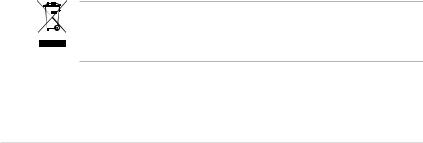
Safety information
Electrical safety
•To prevent electrical shock hazard, disconnect the power cable from the electrical outlet before relocating the system.
•When adding or removing devices to or from the system, ensure that the power cables for the devices are unplugged before the signal cables are connected. If possible, disconnect all power cables from the existing system before you add a device.
•Before connecting or removing signal cables from the motherboard, ensure that all power cables are unplugged.
•Seek professional assistance before using an adapter or extension cord. These devices could interrupt the grounding circuit.
•Make sure that your power supply is set to the correct voltage in your area. If you are not sure about the voltage of the electrical outlet you are using, contact your local power company.
•If the power supply is broken, do not try to fix it by yourself. Contact a qualified service technician or your retailer.
Operation safety
•Before installing the motherboard and adding devices on it, carefully read all the manuals that came with the package.
•Before using the product, make sure all cables are correctly connected and the power cables are not damaged. If you detect any damage, contact your dealer immediately.
•To avoid short circuits, keep paper clips, screws, and staples away from connectors, slots, sockets and circuitry.
•Avoid dust, humidity, and temperature extremes. Do not place the product in any area where it may become wet.
•Place the product on a stable surface.
•If you encounter technical problems with the product, contact a qualified service technician or your retailer.
This symbol of the crossed out wheeled bin indicates that the product (electrical, electronic equipment, and mercury-containing button cell battery) should not
be placed in municipal waste. Check local regulations for disposal of electronic products.
viii

About this guide
This user guide contains the information you need when installing and configuring the motherboard.
How this guide is organized
This user guide contains the following parts:
•Chapter 1: Product introduction
This chapter describes the features of the motherboard and the new technologies it supports.
•Chapter 2: Hardware information
This chapter lists the hardware setup procedures that you have to perform when installing system components. It includes description of the switches, jumpers, and connectors on the motherboard.
•Chapter 3: Powering up
This chapter describes the power up sequence and ways of shutting down the system.
•Chapter 4: BIOS setup
This chapter tells how to change system settings through the BIOS Setup menus. Detailed descriptions of the BIOS parameters are also provided.
•Chapter 5: RAID configuration
This chapter provides instructions for setting up, creating, and configuring RAID sets using the available utilities.
•Chapter 6: Driver installation
This chapter provides instructions for installing the necessary drivers for different system components.
•Appendix: Reference information
This appendix includes additional information that you may refer to when configuring the motherboard.
Where to find more information
Refer to the following sources for additional information and for product and software updates.
1.ASUS websites
The ASUS website provides updated information on ASUS hardware and software products. Refer to the ASUS contact information.
2.Optional documentation
Your product package may include optional documentation, such as warranty flyers, that may have been added by your dealer. These documents are not part of the standard package.
ix

Conventions used in this guide
To make sure that you perform certain tasks properly, take note of the following symbols used throughout this manual.
DANGER/WARNING: Information to prevent injury to yourself when trying to complete a task.
CAUTION: Information to prevent damage to the components when trying to complete a task.
IMPORTANT: Instructions that you MUST follow to complete a task.
NOTE: Tips and additional information to help you complete a task.
Typography
Bold text |
Indicates a menu or an item to select. |
Italics |
Used to emphasize a word or a phrase. |
<Key> |
Keys enclosed in the less-than and greater- |
|
than sign means that you must press the |
|
enclosed key. |
|
Example: <Enter> means that you must press |
|
the Enter or Return key. |
<Key1+Key2+Key3> |
If you must press two or more keys |
|
simultaneously, the key names are linked with |
|
a plus sign (+). |
|
Example: <Ctrl+Alt+D> |
Command |
Means that you must type the command |
|
exactly as shown, then supply the required |
|
item or value enclosed in brackets. |
|
Example: At the DOS prompt, type the |
|
command line: format A:/S |
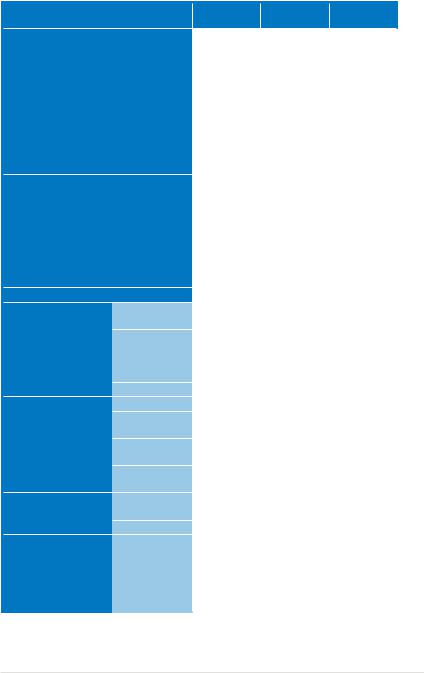
Z8NH-D12 Series specifications summary
Model Name |
|
Z8NH-D12 |
Z8PH-D12/IFB Z8PH-D12 |
||
Processor Support / System Bus |
2 * socket 1366 |
|
SE/QDR |
||
|
|
|
|||
|
|
Six/Quad-Core Intel® Xeon® X5600 Series |
|
||
|
|
(130W/95W) |
|
|
|
|
|
Six/Quad-Core Intel® Xeon® L5600 Series |
|||
|
|
(60W/40W) |
|
|
|
|
|
Quad-Core Intel® Xeon® E5600 Series (80W) |
|||
|
|
Quad-Core Intel® Xeon® X5500 Series (95W) |
|||
|
|
Quad-Core Intel® Xeon® E5500 Series (80W) |
|||
|
|
Quad-Core Intel® Xeon® L5500 Series |
|||
|
|
(60W/38W) |
|
|
|
Core Logic |
|
QPI 4.8 / 5.86 / 6.4 GT/s |
|
|
|
|
Intel® 5500 |
Intel® 5520 |
Intel® 5520 |
|
|
|
|
chipset IOH |
chipset IOH |
chipset IOH |
|
|
|
Intel® ICH10R I/O Controller |
|
|
|
|
|
|
|
|
|
|
|
|
Mellanox |
Mellanox |
|
|
|
|
ConnectX |
ConnectX-2 |
|
|
|
|
MT25408 |
MT25418 B0 |
|
|
|
|
DDR 20Gbps |
QDR 40Gbps |
|
Form Factor |
|
|
controller |
controller |
|
|
6.3” x 16.7” |
|
|
|
|
ASUS Features |
Fan Speed |
|
|
|
|
V |
V |
V |
|||
|
Control |
|
|
|
|
|
Rack Ready |
V |
V |
V |
|
|
(Rack and |
|
|
|
|
|
Pedestal dual |
|
|
|
|
|
use) |
|
|
|
|
|
ASWM |
V |
V |
V |
|
Memory |
Total Slots |
12 (3-channel per CPU, 6 DIMM per CPU) |
|||
|
Capacity |
|
|
|
|
|
Maximum up to 96GB (RDIMM) |
|
|
||
|
Memory Type |
Maximum up to 48GB (UDIMM) |
|
|
|
|
DDR3 800/1066/1333 Reg DIMM/ Unbuffered |
||||
|
Memory Size |
DIMM with ECC |
|
|
|
|
1GB, 2GB, 4GB, 8GB* (RDIMM) |
||||
Expansion Slots |
Total PCI/PCI-X/ |
1GB, 2GB, 4GB (UDIMM) |
|
|
|
1 |
1 |
1 |
|
||
(follow SSI Loacation #) PCI-E Slots |
|
|
|
|
|
|
Slot Loacation 6 |
1 * PCI-E x16 (Gen2 x16 Link) |
|
|
|
Storage |
SATA Controller |
Intel® ICH10R: |
|
|
|
|
|
4 SATA2 300MB/s ports |
|
|
|
|
|
Intel Matrix Storage (for Windows only) |
|||
|
|
(Support software RAID 0, 1, 10 & 5) |
|||
|
|
LSI® MegaRAID (for Linux/Windows) |
|||
|
|
(Support software RAID 0, 1, 10) |
|||
xi
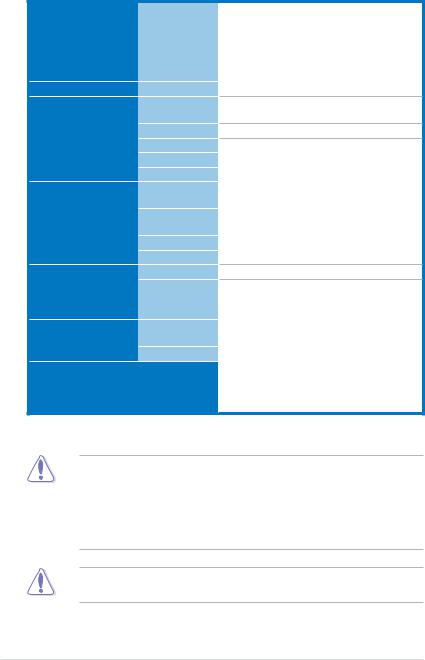
Z8NH-D12 Series specifications summary
Networking LAN
Graphic |
VGA |
Onboard I/O |
PSU Connector |
Connectors |
USB Connectors |
|
|
|
Fan Header |
|
SMBus |
|
Front LAN LED |
Rear I/O Connectors |
External Serial |
|
Port |
|
External USB |
|
Port |
|
VGA Port |
|
RJ-45 |
Management Solution |
Software |
|
Out of Band |
|
Remote |
|
Management |
Monitoring |
CPU |
|
Temperature |
Environment |
FAN RPM |
|
2 * Intel 82574L + 1 * Management LAN
|
1 * Single Port |
1 * Single Port |
|
DDR Infiniband |
QDR Infiniband |
|
20Gbps with |
40Gbps |
|
CX4 interface |
with QSFP |
|
|
interface |
Aspeed AST2050 8MB |
|
|
2 * 20-pin 12V power connector
1 * 4-pin Molex connector for hard disk drive
2 (One for internal Type A USB connector )
4 * 4pin (4pin FAN Only)
2 |
2 |
2 |
2 |
2 |
2 |
1 |
1 |
1 |
|
|
|
2 |
2 |
2 |
|
|
|
1 |
1 |
1 |
2 + 1 Management Port
ASWM
Optional ASMB4-iKVM for KVM-over-IP support
V |
V |
V |
|
|
|
V |
V |
V |
Operation temperature: 10 —35 Non operation temperature: -40 —70
Non operation humidity: 20%—90% ( Non condensing)
Specifications are subject to change without notice.
•The 20-pin proprietory power connectors are not compatible with SSI power
supply. USE THE PROPRIETARY POWER SUPPLY ONLY; otherwise you may damage the motherboard.
•The 4-pin Molex connector is designed for hard disk drive only. DO NOT connect other 4-pin power connectors of the power supply unit (PSU) to this connector.
DO NOT touch the Northbridge chipset! The Northbridge chipset may become overheated. Remember to provide sufficient air flow to keep the system stable.
xii
This chapter describes the motherboard |
|
1 |
|
|
|
features and the new technologies it supports. |
|
|
|
|
Product |
|
introduction |
|

|
|
Chapter summary |
1 |
|
|
|
|
1.1 |
Welcome!....................................................................................... |
1-3 |
1.2 |
Package contents......................................................................... |
1-3 |
1.3 |
Serial number label....................................................................... |
1-4 |
1.4 |
Special features............................................................................ |
1-4 |
ASUS Z8NH-D12 Series
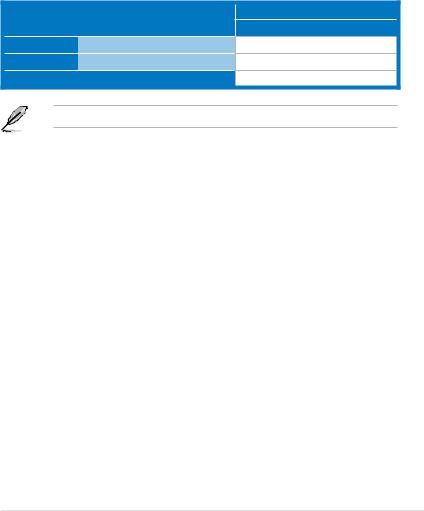
1.1Welcome!
Thank you for buying an ASUS® Z8NH-D12 Series motherboard!
The motherboard delivers a host of new features and latest technologies, making it another standout in the long line of ASUS quality motherboards!
Before you start installing the motherboard, and hardware devices on it, check the items in your package with the list below.
1.2Package contents
Check your motherboard package for the following items.
Application CD Support CD
Documentation User Guide
Packing Qty.
Standard Bulk Pack
Z8NH-D12 Series
1
1
10pcs per carton
If any of the above items is damaged or missing, contact your retailer.
ASUS Z8NH-D12 Series |
1-3 |

1.3Serial number label
Before requesting support from the ASUS Technical Support team, you must take note of the motherboard's serial number containing 13 characters xxS2xxxxxxxxx
shown as the figure below. With the correct serial number of the product, ASUS Technical Support team members can then offer a quicker and satisfying solution to your problems.
|
|
Z8NH-D12 |
Made |
|
in |
|
China |
xxS2xxxxxxxxx |
|
1.4Special features
1.4.1Product highlights
Latest processor technology
This motherboard supports the latest Intel Xeon 5500 series processors in LGA 1366 package with integrated memory controller to support 3-channel (6 DIMM per CPU) DDR3 memory. Intel Xeon 5500 series processor supports Intel QuickPath Interconnect (QPI) with a system bus of up to 6.4GT/s and a max bandwidth of up to 25.6GB/s. Intel Xeon 5500 series processor is the one of the most powerful and energy-efficient CPUs in the world.
Intel Turbo Boost
Intel Turbo Boost dynamically reroute power to improve performance. The processor will automatically overclock as long as the CPU temperature is allowed.
Intel Hyper Threading
The thread-level parallelism on each processor makes more efficient use of the processor resources, higher processing throughout and improved performance on today's multi-threaded software.
Intel® EM64T 
The motherboard supports Intel® processors with the Intel® EM64T (Extended Memory 64 Technology). The Intel® EM64T feature allows your computer to run on 64-bit operating systems and access larger amounts of system memory for faster and more efficient computing.
1-4 |
Chapter 1: Product introduction |

DDR3 memory support
The Z8NH-D12 Series supports UDIMM and RDIMM DDR3 memory that features data transfer rates of 1333/1066 MHZ to meet the higher bandwidth requirements of server and workstation applications. The 3-channel DDR3 architecture boosts system performance, eliminating bottlenecks with peak bandwidth of up to 17GB/s. Furthermore, the supply voltage for the memory is reduced form 1.8 V for DDR2 to just 1.5V for DDR3. This voltage reduction limits the power consumption and heat generation of DDR3 which makes it an ideal memory solution.
PCIe 2.0 
This motherboard supports the latest PCIe 2.0 device for twice the current speed and bandwidth. This enhances system performance while still providing backward compatibility to PCIe 1.0 devices.
82574L LAN Solution
The motherboard comes with dual Gigabit LAN controllers and ports which provide a total solution for your networking needs. The onboard Intel 82574L Gigabit LAN controllers use the PCI Express interface and could achieve network throughput close to Gigabit bandwidth.
Enhanced Intel SpeedStep Technology (EIST)
The Enhanced Intel SpeedStep Technology (EIST) intelligently manages the CPU resources by automatically adjusting the CPU voltage and core frequency depending on the CPU loading and system speed or power requirement.
Serial ATA II technology 
The motherboard supports the Serial ATA II 3 Gb/s technology through the Serial ATA interface and Intel ICH10R chipset. The Serial ATA II specification provides twice the bandwidth of the current Serial ATA products with a host of new features, including Native Command Queuing (NCQ), Power Management (PM) Implementation Algorithm, and Hot Swap. Serial ATA allows thinner, more flexible cables with lower pin count and reduced voltage requirements.
USB 2.0 technology 
The motherboard implements the Universal Serial Bus (USB) 2.0 specification, dramatically increasing the connection speed from the 12 Mbps bandwidth on USB 1.1 to a fast 480 Mbps on USB 2.0. USB 2.0 is backward compatible with USB 1.1.
ASUS Z8NH-D12 Series |
1-5 |

Temperature, fan, and voltage monitoring
The CPU temperature is monitored to prevent overheating and damage. The system fan rotations per minute (RPM) is monitored for timely failure detection. The chip monitors the voltage levels to ensure stable supply of current for critical components.
100% Japan-made Conductive Polymer Capacitors 
This motherboard uses all high-quality conductive polymer capacitors for durability, improved lifespan, and enhanced thermal capacity.
1.4.2Innovative ASUS features
ASUS EPU
With current trends leaning towards power efficiency, the Z8NH-D12 Series is equipped with the ASUS exclusive EPU technology to provide total system power saving by detecting current CPU loadings and intelligently moderating power in real-time.
1-6 |
Chapter 1: Product introduction |
This chapter lists the hardware setup procedures that you have to perform when installing system components. It includes description of the jumpers and connectors on the motherboard.
Hardware2 information

|
|
Chapter summary |
2 |
|
|
|
|
2.1 |
Before you proceed...................................................................... |
2-3 |
2.2 |
Motherboard overview................................................................. |
2-5 |
2.3 |
Central Processing Unit (CPU).................................................. |
2-11 |
2.4 |
System memory.......................................................................... |
2-16 |
2.5 |
Expansion slots.......................................................................... |
2-19 |
2.6 |
Jumpers....................................................................................... |
2-22 |
2.7 |
Connectors.................................................................................. |
2-28 |
ASUS Z8NH-D12 Series
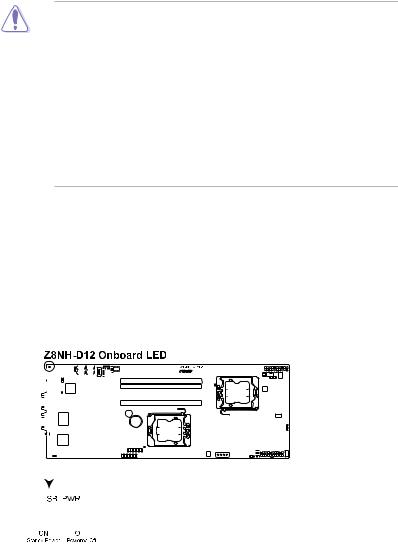
2.1Before you proceed
Take note of the following precautions before you install motherboard components or change any motherboard settings.
•Unplug the power cord from the wall socket before touching any component.
•Use a grounded wrist strap or touch a safely grounded object or a metal object, such as the power supply case, before handling components to avoid damaging them due to static electricity.
•Hold components by the edges to avoid touching the ICs on them.
•Whenever you uninstall any component, place it on a grounded antistatic pad or in the bag that came with the component.
•Before you install or remove any component, ensure that the power supply is switched off or the power cord is detached from the power supply. Failure to do so may cause severe damage to the motherboard, peripherals, and/or components.
Onboard LED
1.Standby Power LED
The motherboard comes with a standby power LED. The green LED lights up to indicate that the system is ON, in sleep mode, or in soft-off mode. This is a reminder that you should shut down the system and unplug the power cable before removing or plugging in any motherboard component. The illustration below shows the location of the onboard LED.
|
|
|
|
|
|
|
|
|
|
|
|
|
|
|
|
|
|
|
|
|
|
|
|
|
|
|
|
|
|
|
|
|
|
|
|
|
|
|
|
|
|
|
|
|
|
|
|
|
|
|
|
|
|
|
|
|
|
|
|
|
|
|
|
|
|
|
|
|
|
|
|
|
|
|
|
|
|
|
|
|
|
|
|
|
|
|
|
|
|
|
|
|
|
|
|
|
|
|
|
|
|
|
|
|
|
|
|
|
|
|
|
|
|
|
|
|
|
|
|
|
|
|
|
|
|
|
|
|
|
|
|
|
|
|
|
|
|
|
|
|
|
|
|
|
|
|
|
|
|
|
|
|
|
|
|
|
|
|
|
|
|
|
|
|
|
|
|
|
|
|
|
|
|
|
|
|
|
|
|
|
|
|
|
|
|
|
|
|
|
|
|
|
|
|
|
|
|
|
|
|
|
|
|
|
|
|
|
|
|
|
|
|
|
|
|
|
|
|
|
|
|
|
|
|
|
|
|
|
|
|
|
|
|
|
|
|
|
|
|
|
|
|
|
|
|
|
|
|
|
|
|
|
|
|
|
|
|
|
|
|
|
|
|
|
|
|
|
|
|
|
|
|
|
|
|
|
|
|
|
|
|
|
|
|
|
|
|
|
|
|
|
|
|
|
|
|
|
|
|
|
|
|
|
|
|
|
|
|
|
|
|
|
|
|
|
|
|
|
|
|
|
|
|
|
|
|
|
|
|
|
|
|
|
|
|
|
|
|
|
|
|
|
|
|
|
|
|
|
|
|
|
|
|
|
|
|
|
|
|
|
|
|
|
|
|
|
|
|
|
|
|
|
|
|
|
|
|
|
|
ASUS Z8NH-D12 Series |
2-3 |
||||||||||||||||||||||||||||||||||||
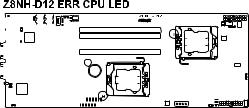
2.CPU warning LED (ERR_CPU1, ERR_CPU2)
The CPU warning LEDs light up to indicate that an impending failure of the corresponding CPU.
|
|
|
|
|
|
|
|
|
|
|
|
|
|
|
|
|
|
|
|
|
|
|
|
|
|
|
|
|
|
|
|
|
|
|
|
|
|
|
|
|
|
|
|
|
|
|
|
|
|
|
|
|
|
|
|
|
|
|
|
|
|
|
|
|
|
|
|
|
|
|
|
|
|
|
|
|
|
|
|
|
|
|
|
|
|
|
|
|
|
|
|
|
|
|
|
|
|
|
|
|
|
|
|
|
|
|
|
|
|
|
|
|
|
|
|
|
|
|
|
|
|
|
|
|
|
|
|
|
|
|
|
|
|
|
|
|
|
|
|
|
|
|
|
|
|
|
|
|
|
|
|
|
|
|
|
|
|
|
|
|
|
|
|
|
|
|
|
|
|
|
|
|
|
|
|
2-4 |
|
|
|
|
|
|
|
|
|
|
|
|
|
|
|
|
|
|
|
|
|
|
|
|
|
|
|
|
|
|
|
|
|
|
|
|
|
|
Chapter 2: Hardware information |
||||
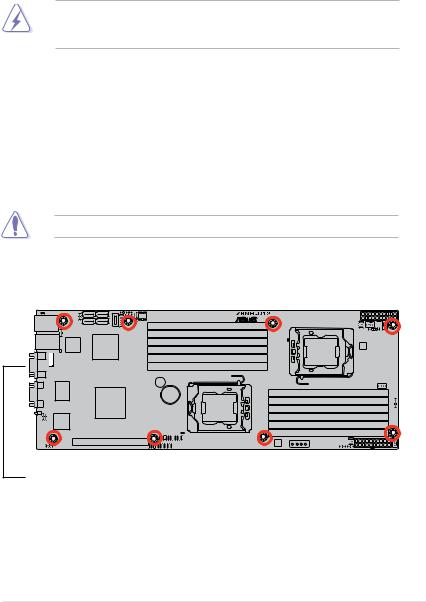
2.2Motherboard overview
Before you install the motherboard, study the configuration of your chassis to ensure that the motherboard fits into it.
To optimize the motherboard features, we highly recommend that you install it in an SSI EEB 1.1 compliant chassis.
Ensure to unplug the chassis power cord before installing or removing the motherboard. Failure to do so can cause you physical injury and damage motherboard components!
2.2.1Placement direction
When installing the motherboard, ensure that you place it into the chassis in the correct orientation. The edge with external ports goes to the rear part of the chassis as indicated in the image below.
2.2.2Screw holes
Place eight (8) screws into the holes indicated by circles to secure the motherboard to the chassis.
DO NOT overtighten the screws! Doing so can damage the motherboard.
Place this side towards the rear of the chassis
ASUS Z8NH-D12 Series |
2-5 |
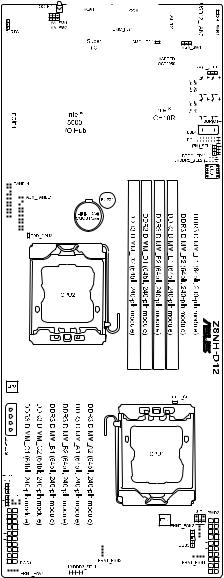
2.2.4Motherboard layouts
Z8NH-D12
|
|
|
|
|
|
|
|
|
|
|
|
|
|
|
|
|
|
|
|
|
|
|
|
|
|
|
|
|
|
|
|
|
|
|
|
|
|
|
|
|
|
|
|
|
|
|
|
|
|
|
|
|
|
|
|
|
|
|
|
|
|
|
|
|
|
|
|
|
|
|
|
|
|
|
|
|
|
|
|
|
|
|
|
|
|
|
|
|
|
|
|
|
|
|
|
|
|
|
|
|
|
|
|
|
|
|
|
|
|
|
|
|
|
|
|
|
|
|
|
|
|
|
|
|
|
|
|
|
|
|
|
|
|
|
|
|
|
|
|
|
|
|
|
|
|
|
|
|
|
|
|
|
|
|
|
|
|
|
|
|
|
|
|
|
|
|
|
|
|
|
|
|
|
|
|
|
|
|
|
|
|
|
|
|
|
|
|
|
|
|
|
|
|
|
|
|
|
|
|
|
|
|
|
|
|
|
|
|
|
|
|
|
|
|
|
|
|
|
|
|
|
|
|
|
|
|
|
|
|
|
|
|
|
|
|
|
|
|
|
|
|
|
|
|
|
|
|
|
|
|
|
|
|
|
|
|
|
|
|
|
|
|
|
|
|
|
|
|
|
|
|
|
|
|
|
|
|
|
|
|
|
|
|
|
|
|
|
|
|
|
|
|
|
|
|
|
|
|
|
|
|
|
|
|
|
|
|
|
|
|
|
|
|
|
|
|
|
|
|
|
|
|
|
|
|
|
|
|
|
|
|
|
|
|
|
|
|
|
|
|
|
|
|
|
|
|
|
|
|
|
|
|
|
|
|
|
|
|
|
|
|
|
|
|
|
|
|
|
|
|
|
|
|
|
|
|
|
|
|
|
|
|
|
|
|
|
|
|
|
|
|
|
|
|
|
|
|
|
|
|
|
|
|
|
|
|
|
|
|
|
|
|
|
|
|
|
|
|
|
|
|
|
|
|
|
|
|
|
|
|
|
|
|
|
|
|
|
|
|
|
|
|
|
|
|
|
|
|
|
|
|
|
|
|
|
|
|
|
|
|
|
|
|
|
|
|
|
|
|
|
|
|
|
|
|
|
|
|
|
|
|
|
|
|
|
|
|
|
|
|
|
|
|
|
|
|
|
|
|
|
|
|
|
|
|
|
|
|
|
|
|
|
|
|
|
|
|
|
|
|
|
|
|
|
|
|
|
|
|
|
|
|
|
|
|
|
|
|
|
|
|
|
|
|
|
|
|
|
|
|
|
|
|
|
|
|
|
|
|
|
|
|
|
|
|
|
|
|
|
|
|
|
|
|
|
|
|
|
|
|
|
|
|
|
|
|
|
|
|
|
|
|
|
|
|
|
|
|
|
|
|
|
|
|
|
|
|
|
|
|
|
|
|
|
|
|
|
|
|
|
|
|
|
|
|
|
|
|
|
|
|
|
|
|
|
|
|
|
|
|
|
|
|
|
|
|
|
|
|
|
|
|
|
|
|
|
|
|
|
|
|
|
|
|
|
|
|
|
|
|
|
|
|
|
|
|
|
|
|
|
|
|
|
|
|
|
|
|
|
|
|
|
|
|
|
|
|
|
|
|
|
|
|
|
|
|
|
|
|
|
|
|
|
|
|
|
|
|
|
|
|
|
|
|
|
|
|
|
|
|
|
|
|
|
|
|
|
|
|
|
|
|
|
|
|
|
|
|
|
|
|
|
|
|
|
|
|
|
|
|
|
|
|
|
|
|
|
|
|
|
|
|
|
|
|
|
|
|
|
|
|
|
|
|
|
|
|
|
|
|
|
|
|
|
|
|
|
|
|
|
|
|
|
|
|
|
|
|
|
|
|
|
|
|
|
|
|
|
|
|
|
|
|
|
|
|
|
|
|
|
|
|
|
|
|
|
|
|
|
|
|
|
|
|
|
|
|
|
|
|
|
|
|
|
|
|
|
|
|
|
|
|
|
|
|
|
|
|
|
|
|
|
|
|
|
|
|
|
|
|
|
|
|
|
|
|
|
|
|
|
|
|
|
|
|
|
|
|
|
|
|
|
|
|
|
|
|
|
|
|
|
|
|
|
|
|
|
|
|
|
|
|
|
|
|
|
|
|
|
|
|
|
|
|
|
|
|
|
|
|
|
|
|
|
|
|
|
|
|
|
|
|
|
|
|
|
|
|
|
|
|
|
|
|
|
|
|
|
|
|
|
|
|
|
|
|
|
|
|
|
|
|
|
|
|
|
|
|
|
|
|
|
|
|
|
|
|
|
|
|
|
|
|
|
|
|
|
|
|
|
|
|
|
|
|
|
|
|
|
|
|
|
|
|
|
|
|
|
|
|
|
|
|
|
|
|
|
|
|
|
|
|
|
|
|
|
|
|
|
|
|
|
|
|
|
|
|
|
|
|
|
|
|
|
|
|
|
|
|
|
|
|
|
|
|
|
|
|
|
|
|
|
|
|
|
|
|
|
|
|
|
|
|
|
|
|
|
|
|
|
|
|
|
|
|
|
|
|
|
|
|
|
|
|
|
|
|
|
|
|
|
|
|
|
|
|
|
|
|
|
|
|
|
|
|
|
|
|
|
|
|
|
|
|
|
|
|
|
|
|
|
|
|
|
|
|
|
|
|
|
|
|
|
|
|
|
|
|
|
|
|
|
|
|
|
|
|
|
|
|
|
|
|
|
|
|
|
|
|
|
|
|
|
|
|
|
|
|
|
|
|
|
|
|
|
|
|
|
|
|
|
|
|
|
|
|
|
|
|
|
|
|
|
|
|
|
|
|
|
|
|
|
|
|
|
|
|
|
|
|
|
|
|
|
|
|
|
|
|
|
|
|
|
|
|
|
|
|
|
|
|
|
|
|
|
|
|
|
|
|
|
|
|
|
|
|
|
|
|
|
|
|
|
|
|
|
|
|
|
|
|
|
|
|
|
|
|
|
|
|
|
|
|
|
|
|
|
|
|
|
|
|
|
|
|
|
|
|
|
|
|
|
|
|
|
|
|
|
|
|
|
|
|
|
|
|
|
|
|
|
|
|
|
|
|
|
|
|
|
|
|
|
|
|
|
|
|
|
|
|
|
|
|
|
|
|
|
|
|
|
|
|
|
|
|
|
|
|
|
|
|
|
|
|
|
|
|
|
|
|
|
|
|
|
|
|
|
|
|
|
|
|
|
|
|
|
|
|
|
|
|
|
|
|
|
|
|
|
|
|
|
|
|
|
|
|
|
|
|
|
|
|
|
|
|
|
|
|
|
|
|
|
|
|
|
|
|
|
|
|
|
|
|
|
|
|
|
|
|
|
|
|
|
|
|
|
|
|
|
|
|
|
|
|
|
|
|
|
|
|
|
|
|
|
|
|
|
|
|
|
|
|
|
|
|
|
|
|
|
|
|
|
|
|
|
|
|
|
|
|
|
|
|
|
|
|
|
|
|
|
|
|
|
|
|
|
|
|
|
|
|
|
|
|
|
|
|
|
|
|
|
|
|
|
|
|
|
|
|
|
|
|
|
|
|
|
|
|
|
|
|
|
|
|
|
|
|
|
|
|
|
|
|
|
|
|
|
|
|
|
|
|
|
|
|
|
|
|
|
|
|
|
|
|
|
|
|
|
|
|
|
|
|
|
|
|
|
|
|
|
|
|
|
|
|
|
|
|
|
|
|
|
|
|
|
|
|
|
|
|
|
|
|
|
|
|
|
|
|
|
|
|
|
|
|
|
|
|
|
|
|
|
|
|
|
|
|
|
|
|
|
|
|
|
|
|
|
|
|
|
|
|
|
|
|
|
|
|
|
|
|
|
|
|
|
|
|
|
|
|
|
|
|
|
|
|
|
|
|
|
|
|
|
|
|
|
|
|
|
|
|
|
|
|
|
|
|
|
|
|
|
|
|
|
|
|
|
|
|
|
|
|
|
|
|
|
|
|
|
|
|
|
|
|
|
|
|
|
|
|
|
|
|
|
|
|
|
|
|
|
|
|
|
|
|
|
|
|
|
|
|
|
|
|
|
|
|
|
|
|
|
|
|
|
|
|
|
|
|
|
|
|
|
|
|
|
|
|
|
|
|
|
|
|
|
|
|
|
|
|
|
|
|
|
|
|
|
|
|
|
|
|
|
|
|
|
|
|
|
|
|
|
|
|
|
|
|
|
|
|
|
|
|
|
|
|
|
|
|
|
|
|
|
|
|
|
|
|
|
|
|
|
|
|
|
|
|
|
|
|
|
|
|
|
|
|
|
|
|
|
|
|
|
|
|
|
2-6 |
|
|
|
|
|
|
|
|
|
|
|
|
|
|
|
|
|
|
|
|
|
|
|
|
|
|
|
|
|
|
|
|
|
|
|
|
|
|
|
|
|
|
|
|
|
|
|
|
|
Chapter 2: Hardware information |
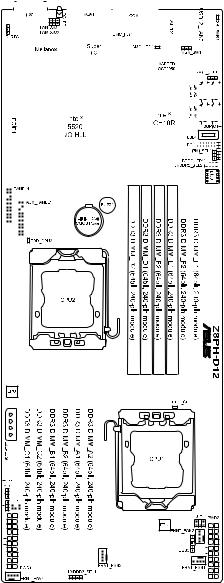
Z8PH-D12/IFB
|
|
|
|
|
|
|
|
|
|
|
|
|
|
|
|
|
|
|
|
|
|
|
|
|
|
|
|
|
|
|
|
|
|
|
|
|
|
|
|
|
|
|
|
|
|
|
|
|
|
|
|
|
|
|
|
|
|
|
|
|
|
|
|
|
|
|
|
|
|
|
|
|
|
|
|
|
|
|
|
|
|
|
|
|
|
|
|
|
|
|
|
|
|
|
|
|
|
|
|
|
|
|
|
|
|
|
|
|
|
|
|
|
|
|
|
|
|
|
|
|
|
|
|
|
|
|
|
|
|
|
|
|
|
|
|
|
|
|
|
|
|
|
|
|
|
|
|
|
|
|
|
|
|
|
|
|
|
|
|
|
|
|
|
|
|
|
|
|
|
|
|
|
|
|
|
|
|
|
|
|
|
|
|
|
|
|
|
|
|
|
|
|
|
|
|
|
|
|
|
|
|
|
|
|
|
|
|
|
|
|
|
|
|
|
|
|
|
|
|
|
|
|
|
|
|
|
|
|
|
|
|
|
|
|
|
|
|
|
|
|
|
|
|
|
|
|
|
|
|
|
|
|
|
|
|
|
|
|
|
|
|
|
|
|
|
|
|
|
|
|
|
|
|
|
|
|
|
|
|
|
|
|
|
|
|
|
|
|
|
|
|
|
|
|
|
|
|
|
|
|
|
|
|
|
|
|
|
|
|
|
|
|
|
|
|
|
|
|
|
|
|
|
|
|
|
|
|
|
|
|
|
|
|
|
|
|
|
|
|
|
|
|
|
|
|
|
|
|
|
|
|
|
|
|
|
|
|
|
|
|
|
|
|
|
|
|
|
|
|
|
|
|
|
|
|
|
|
|
|
|
|
|
|
|
|
|
|
|
|
|
|
|
|
|
|
|
|
|
|
|
|
|
|
|
|
|
|
|
|
|
|
|
|
|
|
|
|
|
|
|
|
|
|
|
|
|
|
|
|
|
|
|
|
|
|
|
|
|
|
|
|
|
|
|
|
|
|
|
|
|
|
|
|
|
|
|
|
|
|
|
|
|
|
|
|
|
|
|
|
|
|
|
|
|
|
|
|
|
|
|
|
|
|
|
|
|
|
|
|
|
|
|
|
|
|
|
|
|
|
|
|
|
|
|
|
|
|
|
|
|
|
|
|
|
|
|
|
|
|
|
|
|
|
|
|
|
|
|
|
|
|
|
|
|
|
|
|
|
|
|
|
|
|
|
|
|
|
|
|
|
|
|
|
|
|
|
|
|
|
|
|
|
|
|
|
|
|
|
|
|
|
|
|
|
|
|
|
|
|
|
|
|
|
|
|
|
|
|
|
|
|
|
|
|
|
|
|
|
|
|
|
|
|
|
|
|
|
|
|
|
|
|
|
|
|
|
|
|
|
|
|
|
|
|
|
|
|
|
|
|
|
|
|
|
|
|
|
|
|
|
|
|
|
|
|
|
|
|
|
|
|
|
|
|
|
|
|
|
|
|
|
|
|
|
|
|
|
|
|
|
|
|
|
|
|
|
|
|
|
|
|
|
|
|
|
|
|
|
|
|
|
|
|
|
|
|
|
|
|
|
|
|
|
|
|
|
|
|
|
|
|
|
|
|
|
|
|
|
|
|
|
|
|
|
|
|
|
|
|
|
|
|
|
|
|
|
|
|
|
|
|
|
|
|
|
|
|
|
|
|
|
|
|
|
|
|
|
|
|
|
|
|
|
|
|
|
|
|
|
|
|
|
|
|
|
|
|
|
|
|
|
|
|
|
|
|
|
|
|
|
|
|
|
|
|
|
|
|
|
|
|
|
|
|
|
|
|
|
|
|
|
|
|
|
|
|
|
|
|
|
|
|
|
|
|
|
|
|
|
|
|
|
|
|
|
|
|
|
|
|
|
|
|
|
|
|
|
|
|
|
|
|
|
|
|
|
|
|
|
|
|
|
|
|
|
|
|
|
|
|
|
|
|
|
|
|
|
|
|
|
|
|
|
|
|
|
|
|
|
|
|
|
|
|
|
|
|
|
|
|
|
|
|
|
|
|
|
|
|
|
|
|
|
|
|
|
|
|
|
|
|
|
|
|
|
|
|
|
|
|
|
|
|
|
|
|
|
|
|
|
|
|
|
|
|
|
|
|
|
|
|
|
|
|
|
|
|
|
|
|
|
|
|
|
|
|
|
|
|
|
|
|
|
|
|
|
|
|
|
|
|
|
|
|
|
|
|
|
|
|
|
|
|
|
|
|
|
|
|
|
|
|
|
|
|
|
|
|
|
|
|
|
|
|
|
|
|
|
|
|
|
|
|
|
|
|
|
|
|
|
|
|
|
|
|
|
|
|
|
|
|
|
|
|
|
|
|
|
|
|
|
|
|
|
|
|
|
|
|
|
|
|
|
|
|
|
|
|
|
|
|
|
|
|
|
|
|
|
|
|
|
|
|
|
|
|
|
|
|
|
|
|
|
|
|
|
|
|
|
|
|
|
|
|
|
|
|
|
|
|
|
|
|
|
|
|
|
|
|
|
|
|
|
|
|
|
|
|
|
|
|
|
|
|
|
|
|
|
|
|
|
|
|
|
|
|
|
|
|
|
|
|
|
|
|
|
|
|
|
|
|
|
|
|
|
|
|
|
|
|
|
|
|
|
|
|
|
|
|
|
|
|
|
|
|
|
|
|
|
|
|
|
|
|
|
|
|
|
|
|
|
|
|
|
|
|
|
|
|
|
|
|
|
|
|
|
|
|
|
|
|
|
|
|
|
|
|
|
|
|
|
|
|
|
|
|
|
|
|
|
|
|
|
|
|
|
|
|
|
|
|
|
|
|
|
|
|
|
|
|
|
|
|
|
|
|
|
|
|
|
|
|
|
|
|
|
|
|
|
|
|
|
|
|
|
|
|
|
|
|
|
|
|
|
|
|
|
|
|
|
|
|
|
|
|
|
|
|
|
|
|
|
|
|
|
|
|
|
|
|
|
|
|
|
|
|
|
|
|
|
|
|
|
|
|
|
|
|
|
|
|
|
|
|
|
|
|
|
|
|
|
|
|
|
|
|
|
|
|
|
|
|
|
|
|
|
|
|
|
|
|
|
|
|
|
|
|
|
|
|
|
|
|
|
|
|
|
|
|
|
|
|
|
|
|
|
|
|
|
|
|
|
|
|
|
|
|
|
|
|
|
|
|
|
|
|
|
|
|
|
|
|
|
|
|
|
|
|
|
|
|
|
|
|
|
|
|
|
|
|
|
|
|
|
|
|
|
|
|
|
|
|
|
|
|
|
|
|
|
|
|
|
|
|
|
|
|
|
|
|
|
|
|
|
|
|
|
|
|
|
|
|
|
|
|
|
|
|
|
|
|
|
|
|
|
|
|
|
|
|
|
|
|
|
|
|
|
|
|
|
|
|
|
|
|
|
|
|
|
|
|
|
|
|
|
|
|
|
|
|
|
|
|
|
|
|
|
|
|
|
|
|
|
|
|
|
|
|
|
|
|
|
|
|
|
|
|
|
|
|
|
|
|
|
|
|
|
|
|
|
|
|
|
|
|
|
|
|
|
|
|
|
|
|
|
|
|
|
|
|
|
|
|
|
|
|
|
|
|
|
|
|
|
|
|
|
|
|
|
|
|
|
|
|
|
|
|
|
|
|
|
|
|
|
|
|
|
|
|
|
|
|
|
|
|
|
|
|
|
|
|
|
|
|
|
|
|
|
|
|
|
|
|
|
|
|
|
|
|
|
|
|
|
|
|
|
|
|
|
|
|
|
|
|
|
|
|
|
|
|
|
|
|
|
|
|
|
|
|
|
|
|
|
|
|
|
|
|
|
|
|
|
|
|
|
|
|
|
|
|
|
|
|
|
|
|
|
|
|
|
|
|
|
|
|
|
|
|
|
|
|
|
|
|
|
|
|
|
|
|
|
|
|
|
|
|
|
|
|
|
|
|
|
|
|
|
|
|
|
|
|
|
|
|
|
|
|
|
|
|
|
|
|
|
|
|
|
|
|
|
|
|
|
|
|
|
|
|
|
|
|
|
|
|
|
|
|
|
|
|
|
|
|
|
|
|
|
|
|
|
|
|
|
|
|
|
|
|
|
|
|
|
|
|
|
|
|
|
|
|
|
|
|
|
|
|
|
|
|
|
|
|
|
|
|
|
|
|
|
|
|
|
|
|
|
|
|
|
|
|
|
|
|
|
|
|
|
|
|
|
|
|
|
|
|
|
|
|
|
|
|
|
|
|
|
|
|
|
|
|
|
|
|
|
|
|
|
|
|
|
|
|
|
|
|
|
|
|
|
|
|
|
|
|
|
|
|
|
|
|
|
|
|
|
|
|
|
|
|
|
|
|
|
|
|
|
|
|
|
|
|
|
|
|
|
|
|
|
|
|
|
|
|
|
|
|
|
|
|
|
|
|
|
|
|
|
|
|
|
|
|
|
|
|
|
|
|
|
|
|
|
|
|
|
|
|
|
|
|
|
|
|
|
|
|
|
|
|
|
|
|
|
|
|
|
|
|
|
|
|
|
|
|
|
|
|
|
|
|
|
|
|
|
|
|
|
|
|
|
|
|
|
|
|
ASUS Z8NH-D12 Series |
2-7 |
|||||||||||||||||||||||||||||||||||||||||||||||||||||
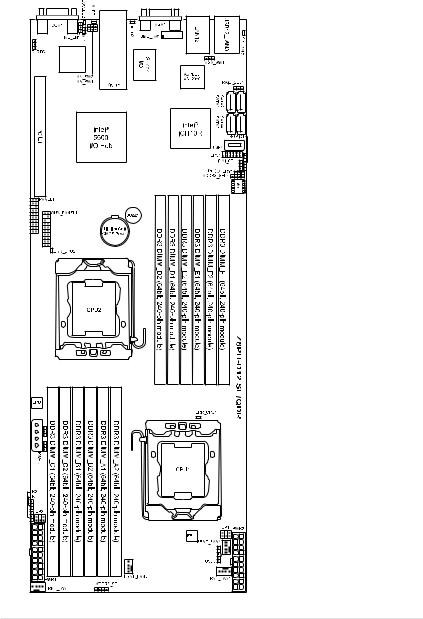
Z8PH-D12 SE/QDR |
2-8 |
Chapter 2: Hardware information |

2.2.5Layout contents
|
Slots/Soocket |
Page |
|
1. |
CPU sockets |
2-10 |
|
|
|
|
|
2. |
DDR3 sockets |
2-15 |
|
|
3. |
PCI Express x 16 slot |
2-20 |
|
Jumpers |
|
Page |
1. |
Clear RTC RAM (CLRTC1) |
2-21 |
|
|
|
|
|
2. |
VGA controller setting (3-pin VGA_SW1)) |
2-22 |
|
|
|
|
|
3. |
DDR3 voltage control setting |
2-22 |
|
|
|
(4-pin LVDDR3_SEL1; LVDDR3_SEL2) |
|
|
|
|
|
|
|
|
|
4. |
LAN controller setting (3-pin LAN_SW1, LAN_SW2) |
2-23 |
|
|
5. |
Intel ICH10R SATA port S/W RAID setting (3-pin RAID_SEL1) |
2-23 |
|
6. |
Force BIOS recovery setting (3-pin RECOVERY1) |
2-24 |
|
Rear panel connectors |
Page |
|
1. |
RJ-45 port for iKVM |
2-25 |
|
|
|
|
|
2. |
USB 2.0 ports 1 and 2 |
2-25 |
|
|
|
|
|
3. |
LAN 1 (RJ-45) port |
2-25 |
|
|
|
|
|
4. |
LAN 2 (RJ-45) port |
2-25 |
|
|
|
|
|
5. |
Serial (COM1) port |
2-25 |
|
|
|
|
|
6. |
Video Graphics Adapter port |
2-25 |
|
|
7. |
Location LED |
2-25 |
|
|
|
|
ASUS Z8NH-D12 Series |
2-9 |

Internal connectors |
Page |
1. |
Serial ATA connectors |
2-26 |
|
(7-pin SATA1, SATA2, SATA3, SATA4) |
|
|
|
|
|
|
|
2. |
USB connector (5-1 pin USB3, A-Type USB4) |
2-27 |
|
|
|
3. |
Thermal sensor cable connectors (3-pin TR1, TR2) |
2-27 |
|
|
|
4. |
Front fan connectors |
2-28 |
|
(4-pin FRNT_FAN1, FRNT_FAN2, FRNT_FAN3, FRNT_FAN4) |
|
|
|
|
|
|
|
5. |
LPC debug card connector (14-1 pin LPC1) |
2-29 |
|
|
|
6. |
Serial General Purpose Input/Output connector (6-1 pin SGPIO1) |
2-29 |
|
|
|
7. |
BMC header (BMC_FW1) |
2-30 |
|
|
|
8. |
Power Supply SMBus connectors (6-1 pin JP1; JP2) |
2-30 |
|
|
|
9. |
Proprietary power connectors |
2-31 |
|
(20-pin PWR1, 20-pin PWR2, 4-pin PWR3) |
|
|
|
|
|
|
|
10. |
System panel connector (20-1 pin PANEL1) |
2-32 |
11. |
Auxiliary panel connector (20-2 pin AUX_PANEL1) |
2-33 |
2-10 |
Chapter 2: Hardware information |
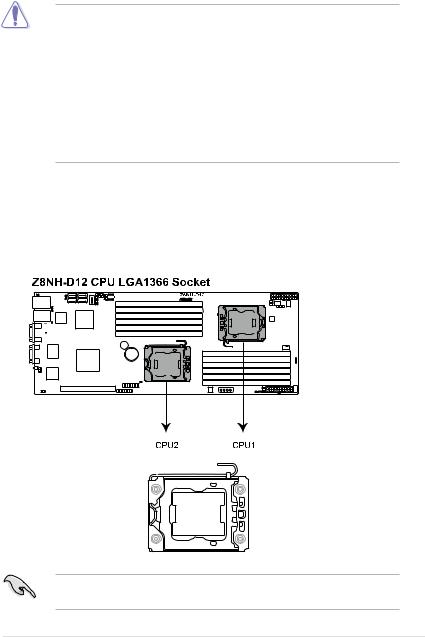
2.3Central Processing Unit (CPU)
The motherboard comes with dual surface mount LGA 1366 Socket designed for the Intel® Xeon 5500 series CPU in the Land Grid Array (LGA) package.
• Upon purchase of the motherboard, ensure that the PnP cap is on the socket and the socket contacts are not bent. Contact your retailer
immediately if the PnP cap is missing, or if you see any damage to the PnP cap/socket contacts/motherboard components. ASUS shoulders the repair cost only if the damage is shipment/transit-related.
•Keep the cap after installing the motherboard. ASUS will process Return Merchandise Authorization (RMA) requests only if the motherboard comes with the cap on the Socket 1366.
•The product warranty does not cover damage to the socket contacts resulting from incorrect CPU installation/removal, or misplacement/loss/ incorrect removal of the PnP cap.
2.3.1Installing the CPU
To install a CPU:
1.Locate the CPU socket on the motherboard.
Before installing the CPU, ensure that the socket box is facing toward you and the load lever is on your left.
ASUS Z8NH-D12 Series |
2-11 |
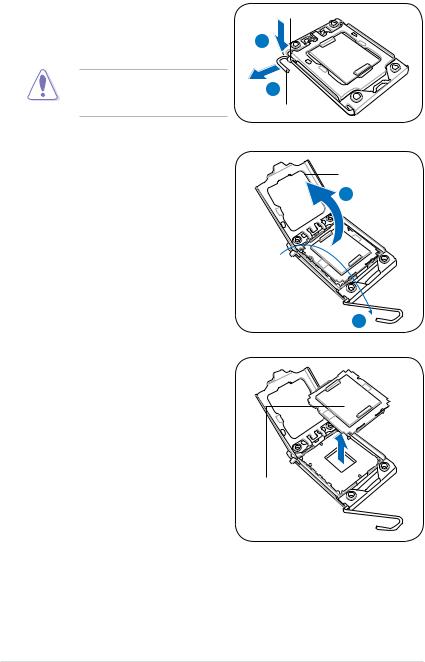
2.Press the load lever with your thumb (A), then move it to the left
(B)until it is released from the retention tab.
To prevent damage to the socket pins, do not remove the PnP cap unless you are installing a CPU.
3.Lift the load lever in the direction of the arrow to a 135º angle.
4.Lift the load plate with your thumb and forefinger to a 100º angle.
Retention tab
A
B
Load lever
Load plate 4
3
5.Remove the PnP cap from the CPU socket.
PnP cap |
2-12 |
Chapter 2: Hardware information |
